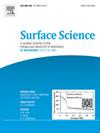非金属掺杂单层WSe2对SO2吸附性能的第一性原理研究
IF 1.8
4区 化学
Q3 CHEMISTRY, PHYSICAL
引用次数: 0
摘要
二氧化硫(SO2)等有害气体对环境和人类健康造成的威胁日益严重,开发高效气敏材料成为重要的研究重点。本研究采用第一性原理密度泛函理论(DFT)系统研究了硅(Si)掺杂在单层WSe2吸附SO2过程中的作用。计算结果表明,Si掺杂显著增强了WSe2对SO2的吸附能力,吸附能从本征态WSe2的-1.364 eV增加到-3.860 eV,表明掺杂增强了材料与气体分子之间的相互作用。进一步分析表明,Si掺杂使WSe2的带隙从1.599 eV减小到1.092 eV。尽管带隙缩小,但材料仍保持其半导体特性。在SO2吸附后,观察到带隙缩小至0.113 eV,这表明由于掺杂和气体吸附的协同作用,材料对气体响应的敏感性增强。在SO2吸附复合体系中,材料的功函数从5.09 eV增加到5.21 eV,表明掺杂和气体吸附的协同作用增强了界面电场,从而优化了电子传递和气体识别能力。差分电荷密度分析表明,Si掺杂和SO2吸附显著诱导了界面电荷转移,提高了气体识别性能和电子响应。光学性能分析表明,Si掺杂和SO2吸附共同提高了材料的光学吸收性能。掺硅WSe2吸附SO2后,中心吸收峰的强度增加到14.39 × 104 cm−1,比本征体系增加了2.1%。本研究结果为高性能气体传感器和光电子器件的设计提供了理论基础,从而为二维材料的光电特性调控开辟了新的途径。本文章由计算机程序翻译,如有差异,请以英文原文为准。

SO2 adsorption properties of non-metal doped single-layer WSe2: A first-principles study
The threat posed by harmful gases such as sulfur dioxide (SO2) to the environment and human health is growing increasingly severe, making developing highly efficient gas-sensing materials a critical research focus. This study employs first-principles density functional theory (DFT) to systematically investigate the role of silicon (Si) doping in the SO2 adsorption process of single-layer WSe2. The computational results indicate that Si doping significantly enhances the adsorption capacity of WSe2 toward SO2, with the adsorption energy increasing from -1.364 eV in intrinsic WSe2 to -3.860 eV, suggesting that doping strengthens the interaction between the material and gas molecules. Further analysis shows that Si doping reduces the bandgap of WSe2 from 1.599 eV to 1.092 eV. Despite the narrowing of the bandgap, the material retains its semiconductor properties. Following the adsorption of SO2, a bandgap narrowing to 0.113 eV was observed, indicating an enhancement in the material’s sensitivity to gas response due to the synergistic effect of doping and gas adsorption. In the composite system with SO2 adsorption, an increase in the work function of the material from 5.09 eV to 5.21 eV was recorded, suggesting an enhancement in the interfacial electric field due to the synergistic effect of doping and gas adsorption, thereby optimising electron transfer and gas recognition capabilities. Differential charge density analysis revealed that Si doping and SO2 adsorption significantly induced interfacial charge transfer, improving gas recognition performance and electronic response. Optical performance analysis demonstrated that Si doping and SO2 adsorption jointly improve the material’s optical absorption properties. The intensity of the central absorption peak following the adsorption of SO2 by Si-doped WSe2 has been shown to increase to 14.39 × 104 cm−1, representing a 2.1 % increase compared with the intrinsic system. The findings of this study provide a theoretical foundation for the design of high-performance gas sensors and optoelectronic devices, thereby opening new avenues for the regulation of the optoelectronic properties of two-dimensional materials.
求助全文
通过发布文献求助,成功后即可免费获取论文全文。
去求助
来源期刊

Surface Science
化学-物理:凝聚态物理
CiteScore
3.30
自引率
5.30%
发文量
137
审稿时长
25 days
期刊介绍:
Surface Science is devoted to elucidating the fundamental aspects of chemistry and physics occurring at a wide range of surfaces and interfaces and to disseminating this knowledge fast. The journal welcomes a broad spectrum of topics, including but not limited to:
• model systems (e.g. in Ultra High Vacuum) under well-controlled reactive conditions
• nanoscale science and engineering, including manipulation of matter at the atomic/molecular scale and assembly phenomena
• reactivity of surfaces as related to various applied areas including heterogeneous catalysis, chemistry at electrified interfaces, and semiconductors functionalization
• phenomena at interfaces relevant to energy storage and conversion, and fuels production and utilization
• surface reactivity for environmental protection and pollution remediation
• interactions at surfaces of soft matter, including polymers and biomaterials.
Both experimental and theoretical work, including modeling, is within the scope of the journal. Work published in Surface Science reaches a wide readership, from chemistry and physics to biology and materials science and engineering, providing an excellent forum for cross-fertilization of ideas and broad dissemination of scientific discoveries.
 求助内容:
求助内容: 应助结果提醒方式:
应助结果提醒方式:


